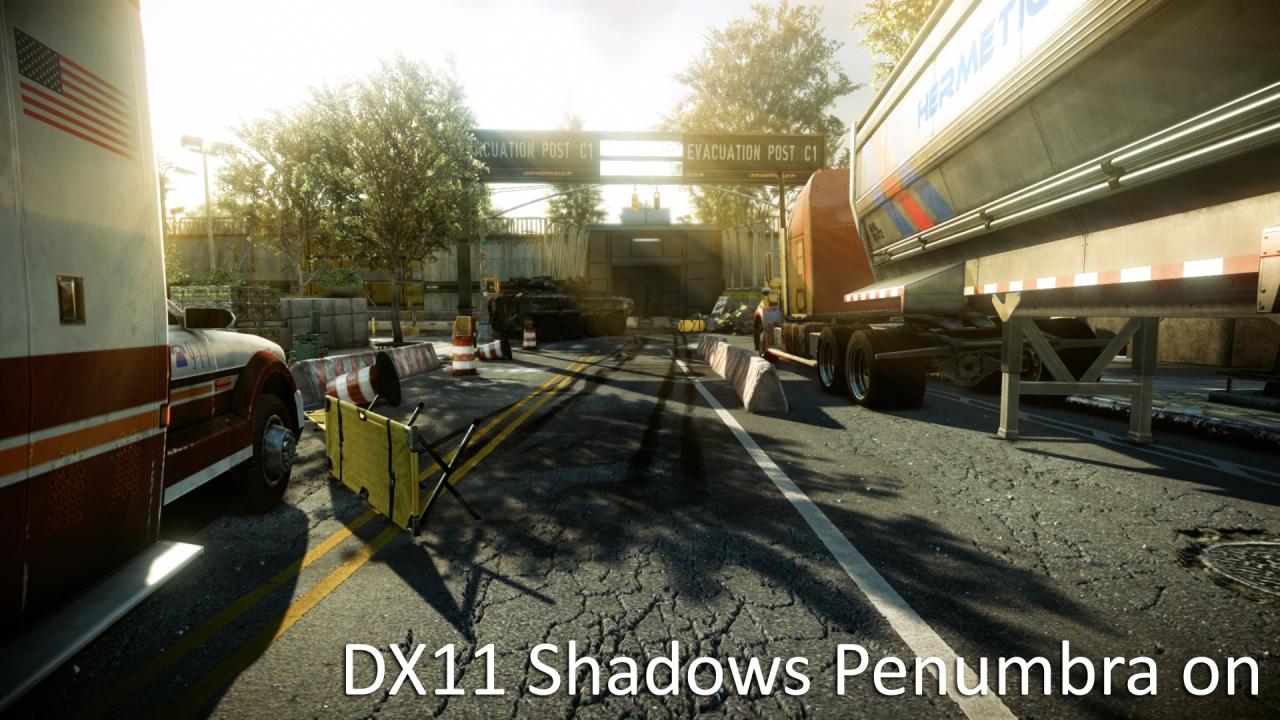Why you can trust GamesRadar+
There are also plenty of “wow” moments that make it feel like a Hollywood blockbuster, but at the same time the campaign only occasionally really blew our hair back. A few factors come together to make the single-player a bit less engaging than it could have been. The first is your non-character. All you know is that your name is Alcatraz. You’re yet another mute empty shell, and we’re really, really getting tired of these non-entities. We don’t feel more connected to our character because he inexplicably never opens his mouth – we feel less so. It would be much more interesting if he had a personality, and it’s distracting and unrealistic when no one questions why you don’t talk. If books and movies can get the audience to identify with a character that’s not a sack of meat, so can videogames.
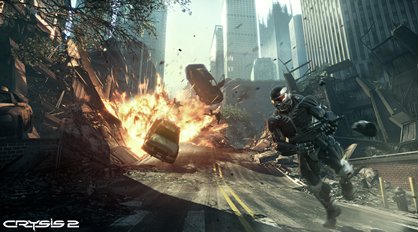
Above: Alcatraz, whose character traits include running, jumping, and shooting
The aliens are also fairly generic. They have tentacles and armor plating and glowing eyes, but there isn’t enough variety in them. There’s a soldier, a wall-climbing stalker, and a big ogre guy, and that’s basically it. There are some ships and few other things we won’t spoil but the bulk of the aliens are just freaky-looking versions of human opponents. They don’t have any special attacks we haven’t seen before that force you to deal with them differently. They’re kind of cool looking, but not memorable.
The biggest flaw in the entire game is something we were not expecting at all: the AI is often buggy. It seems to be a problem with the aliens getting caught on the environment, because we didn’t see too many problems with the human opponents. We did see, though, aliens often freaking out against some obstacle or completely ignoring us while we plinked away at them. We even beat the final battle because the AI couldn’t figure out how to get to us, even though we were just up on a hill. It’s an immersion-breaker, and even more so when the game looks so damn good otherwise. These AI problems were not everywhere and didn’t significantly mar the experience, but they happened more often than what we could just blow off as an occasional bug.
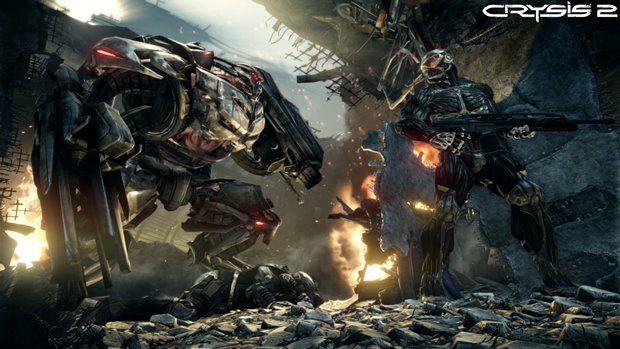
Above: This guy looks scary, but its pretty easy to put an obstacle between you and him and hit his exposed parts, or just wait for him to get confused with the terrain
So the campaign isn’t completely spectacular, but it does have spectacular moments. If you have no interest in multiplayer and like the idea of playing around with the nanosuit’s powers, Crysis 2 is still worth your time and money. Outside of the AI issues, you’ll get a proper big-budget experience with a delectable sheen of gloss that’s possibly unmatched anywhere.
The multiplayer %26ndash; where smarts rule
Crysis 2’s multiplayer doesn’t exactly have original ideas, but the way it blends familiar concepts works beautifully and somehow creates a competitive experience that feels new. It also allows players to blend playstyles and “classes” on the fly, which for those who didn’t play the original Crysis will find refreshing in a shooter market that typically restricts you to a single tone of gameplay per life. What we mean is, typically in a shooter you either have a predetermined or custom class that you can swap out between lives, but in Crysis 2 you can change roles literally from moment to moment, thanks to the nanosuit. While this was also possible in the original Crysis, the sequel streamlines this process, making the multiplayer faster and more fluid.
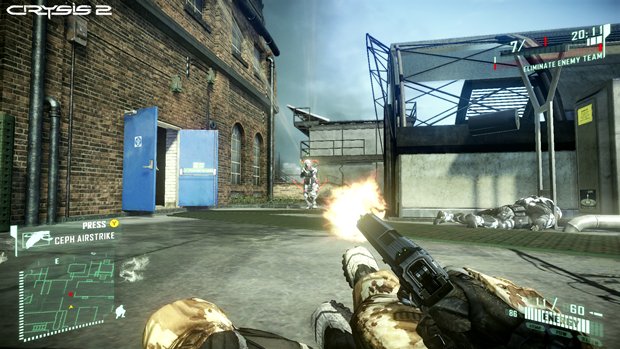
Above: If you can kill someone while you're sliding on the ground, pat yourself on the nanosuited back
We’ve already talked about the nanosuit powers and how they work in the single-player campaign, but in multiplayer they take on a whole new dimension. Against AI you can turn on stealth and be entirely invisible, whereas in multiplayer a keen-eyed player can see your Predator-like shimmer, and furthermore players can use various suit modules and the nanovision to spot would-be ninjas. Invisibility in any multiplayer game is difficult to balance, but Crysis 2 handles it with finesse – there are numerous options for spotting and dealing with stealthers, but at the same time the stealth is still immensely useful and absolutely integral to the gameplay.
We discovered three core “classes” in multiplayer – two of which are obvious, while the third was something we devised on our own. We put quotes around “classes” because we’re not talking about the default loadouts – we’re talking about the three pillars of the nanosuit, which are armor, stealth, and mobility. While you can use all three of them at will, it’s also possible to focus almost entirely on one of these strengths and use it as a playstyle, or “class.” So for instance, you could ignore stealth completely and only use your nanosuit’s energy for armor, turning yourself into a tank/assault frontline fighter. The other obvious style is to focus all of your energy on staying invisible as much as possible.
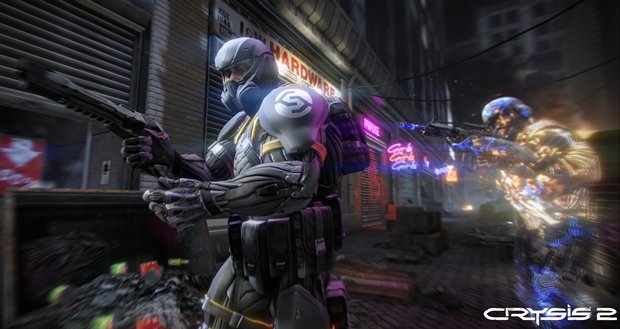
Above: Unlike the single-player, where you're the sole ninja, in multiplayer you need to be real paranoid about what might be just behind you
As is typical with most shooters today, you’ll gain experience and unlock weapons and perks. Crysis 2’s version of the perk is called the suit module, and they each have three levels of increased effectiveness that are unlocked with progress. You can customize your suit modules to maximize your playstyle – for instance, you can use one slot to speed up the time it takes to enter stealth mode. It was through these modules that we devised the third “class” in multiplayer – the mobility-based run-and-gunner. The first two classes are obvious because armor and stealth both drain your energy, so focusing on one ability makes for efficient usage of energy. Sprinting and power-jumping, however, also use energy, and when we saw a suit module that reduces this energy drain, we realized there was another whole playstyle possible.
We created a custom class focused purely on mobility – we equipped only a light SMG as our primary weapon with no attachments (attachments slow you down), we set up the Mobility and Air Stomp suit modules, and we proceeded to not use any armor or stealth at all – instead sprinting, leaping, and sliding all over the map. At first it was difficult to adjust to, but then we were pleased to see it’s a totally viable playstyle, especially on certain gametypes like Crash Site, where we were often the first player to arrive when the pod dropped (heck we were often already below the ship waiting before the pod even dropped).
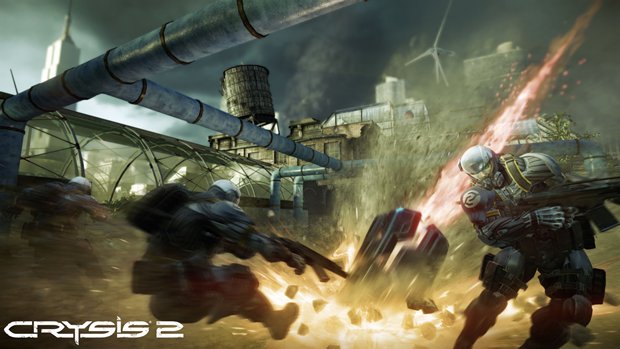
Above: Of course, you might not want to get too close to where to pod lands
Since the real beauty of Crysis 2’s multiplayer is that you don’t have to focus on one class, the best player will be able to blend mobility, armor, and stealth as needed. After we got comfortable just focusing on running and gunning, we started working stealth and armor back into the playstyle, but in a limited capacity – if you’re reloading and have plenty of energy, why not reload while invisible? If you get ambushed and shot in the back, flick on that armor to save your ass. It’s easy to see how you could focus your playstyle in one area but use the others to supplement it, or balance them all as a jack-of-all trades type.
More info
| Genre | Shooter |
| Description | The PC version will kill your computer, but then it's better looking than the console versions, which happen have possibly the best-looking console graphics in history. The single-player campaign is pretty good, with some genuinely spectacular set pieces, while the multiplayer is flat-out fantastic, providing a fresh experience that lets you blend playstyles at will. |
| Franchise name | Crysis |
| Platform | "PC","Xbox 360","PS3" |
| US censor rating | "Mature","Mature","Mature" |
| UK censor rating | "Rating Pending","Rating Pending","Rating Pending" |
| Release date | 1 January 1970 (US), 1 January 1970 (UK) |
